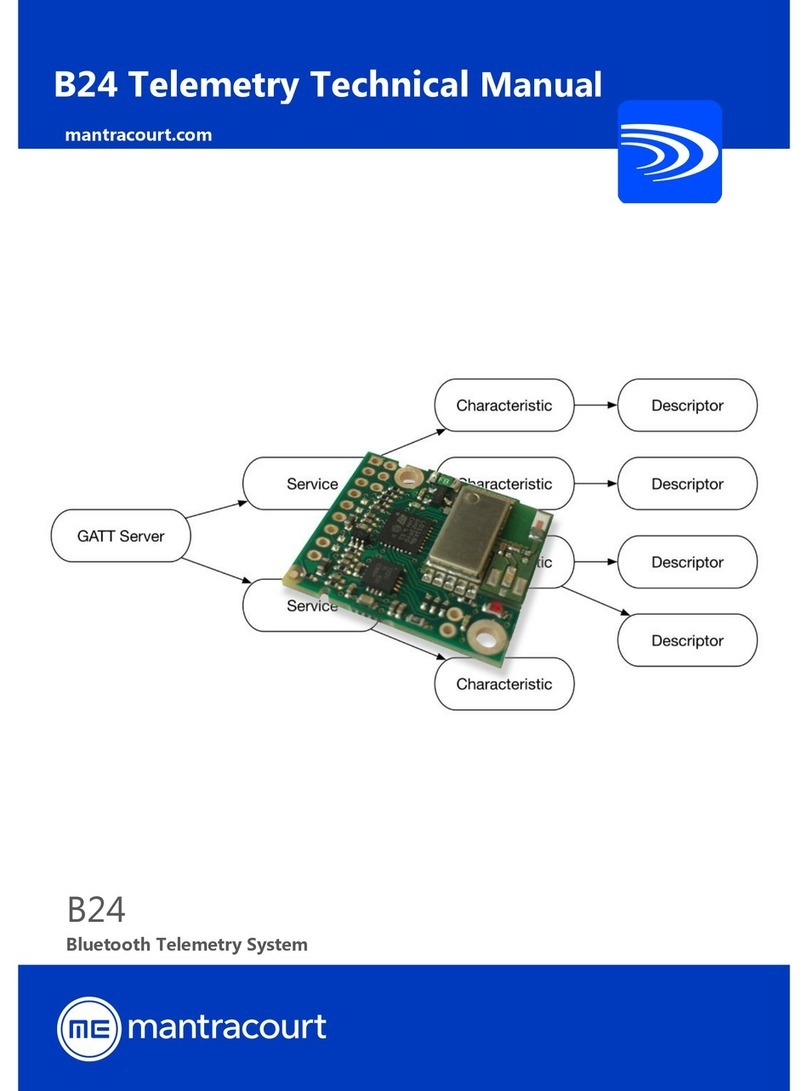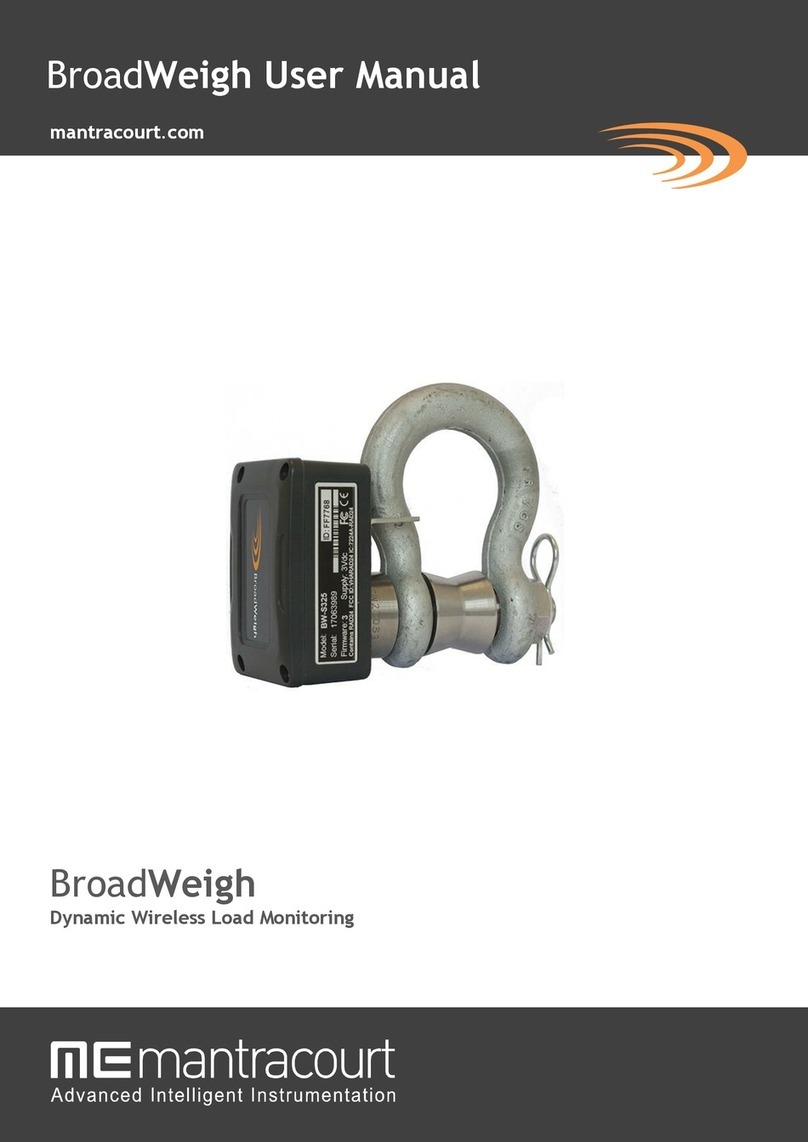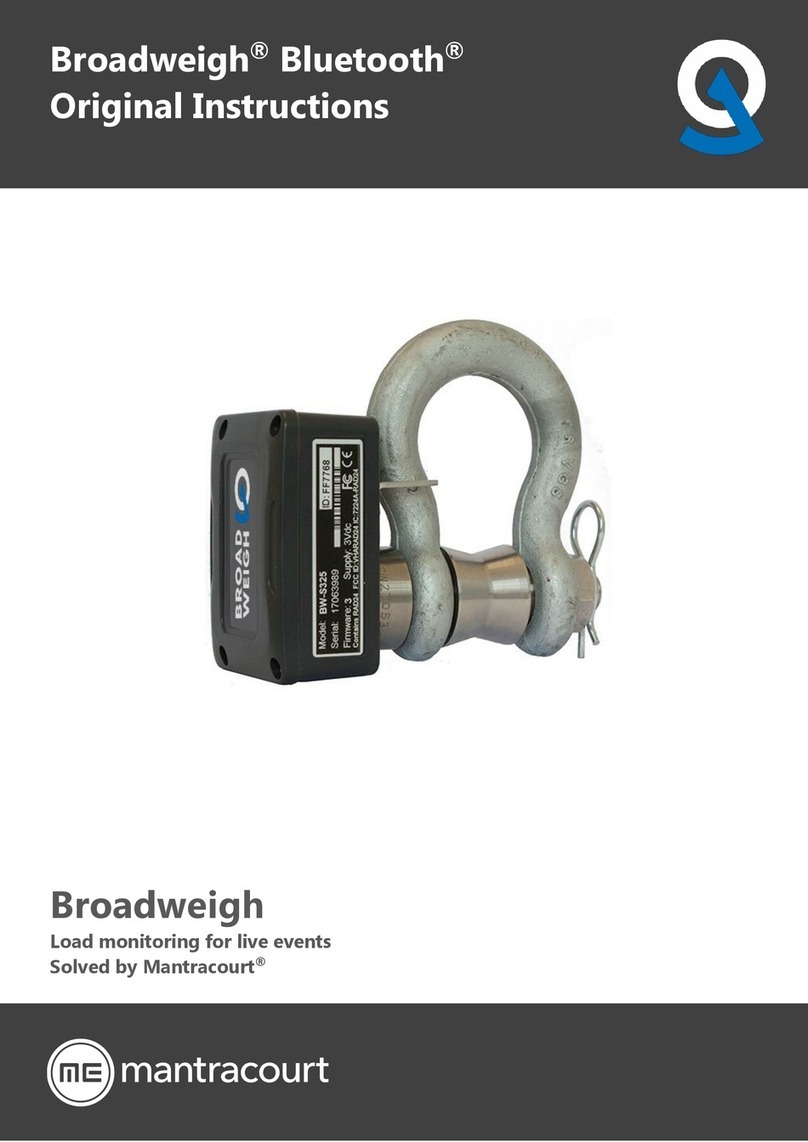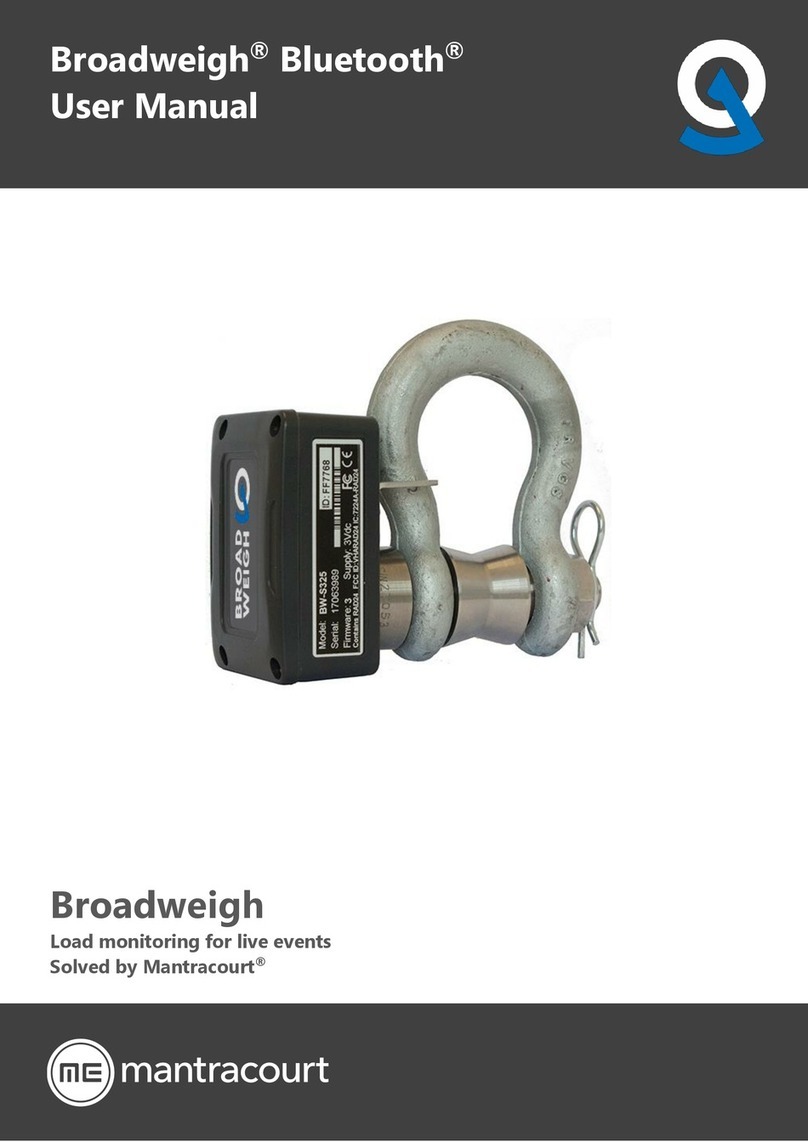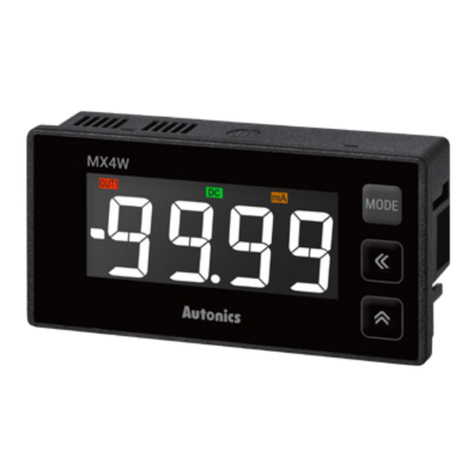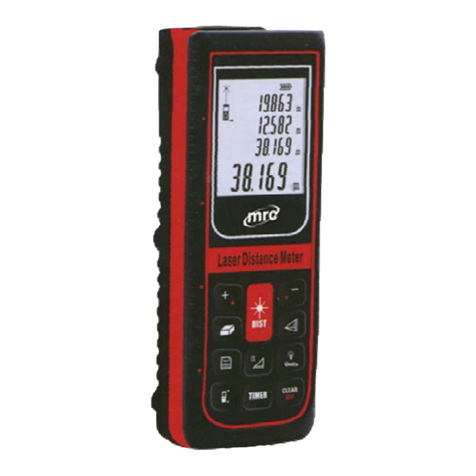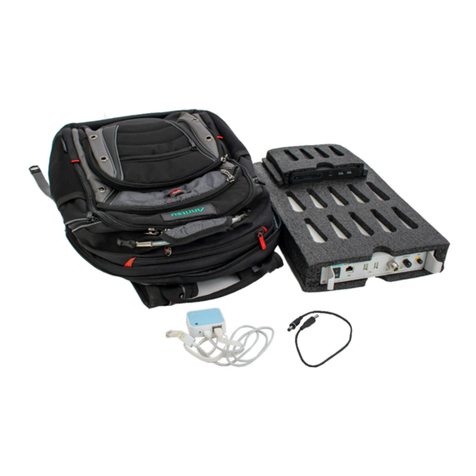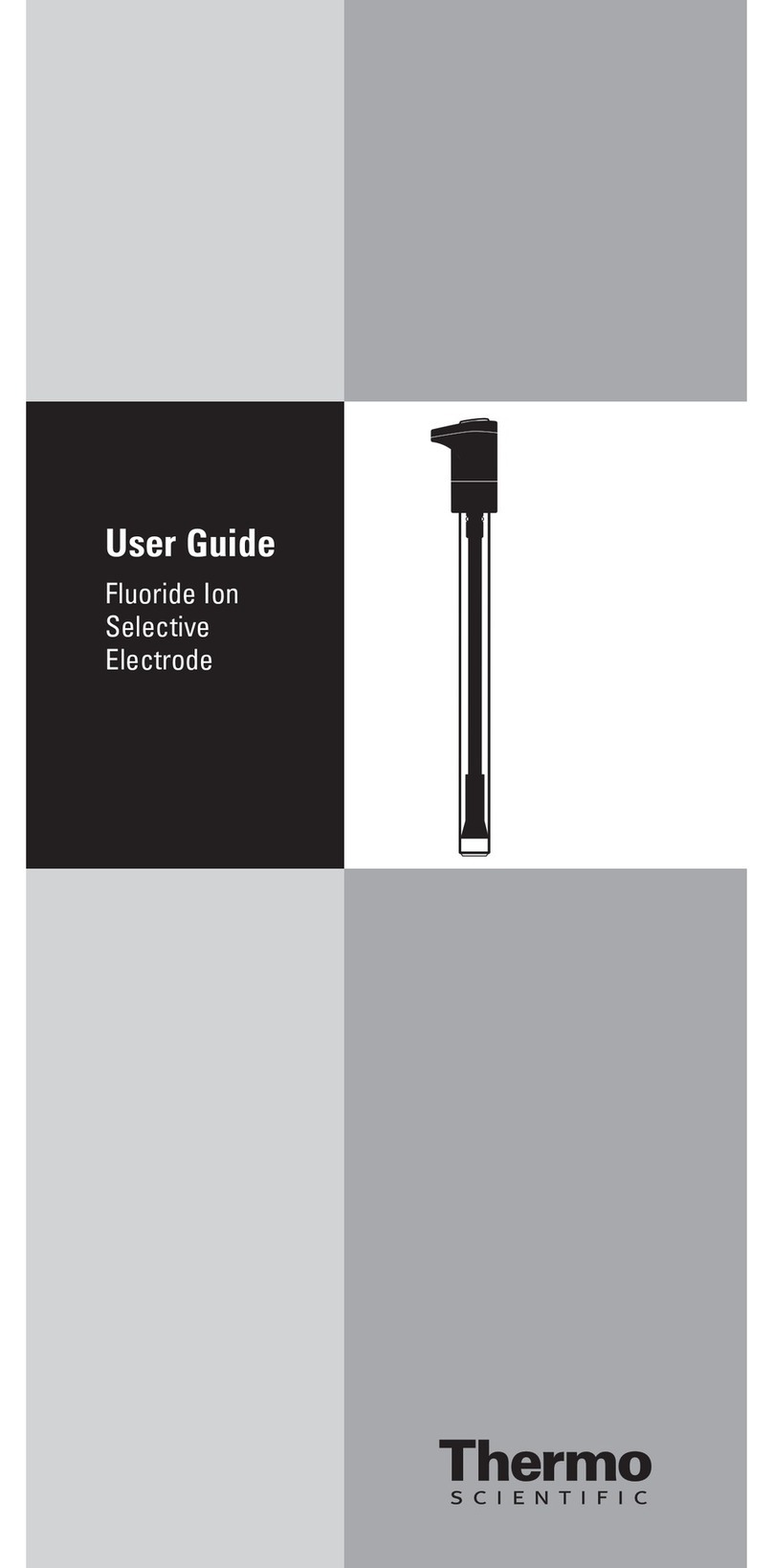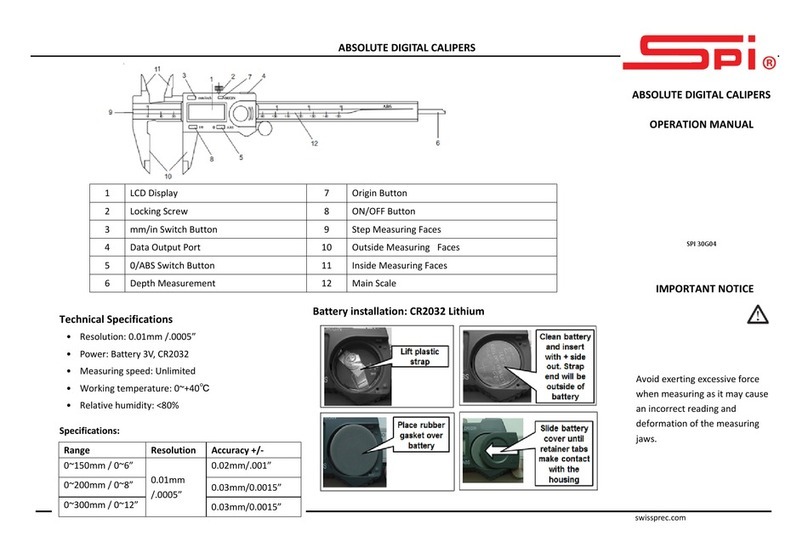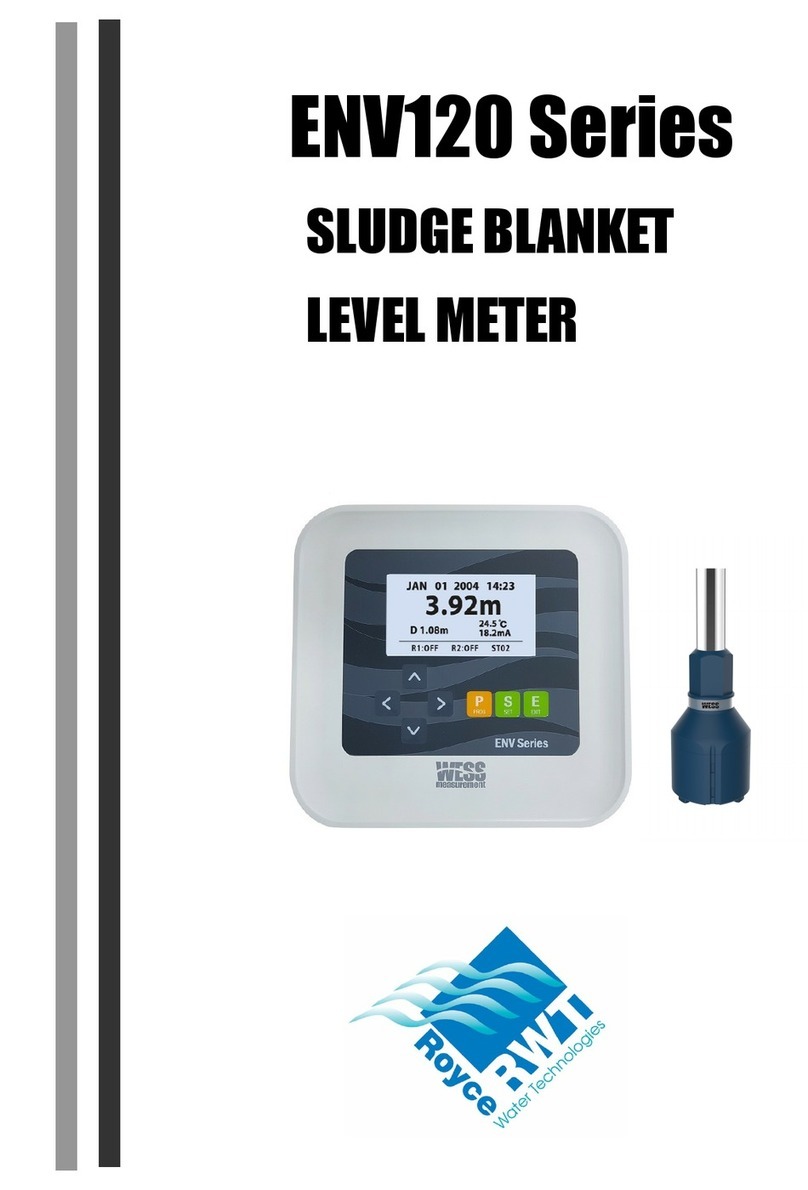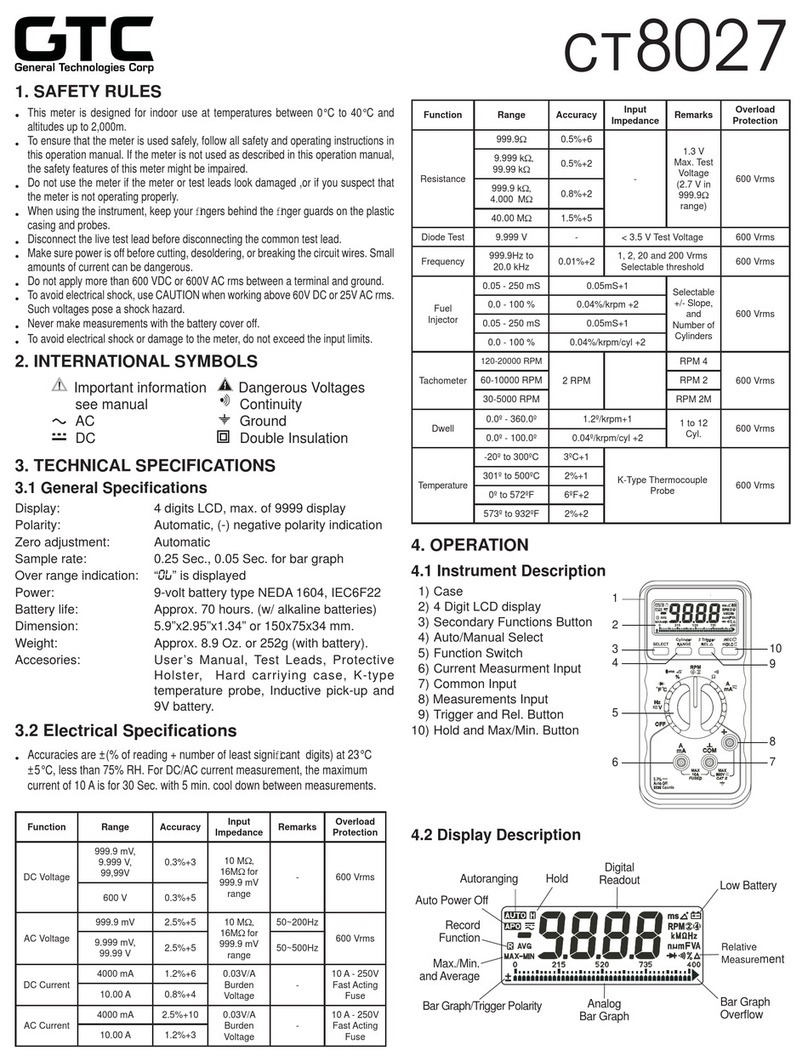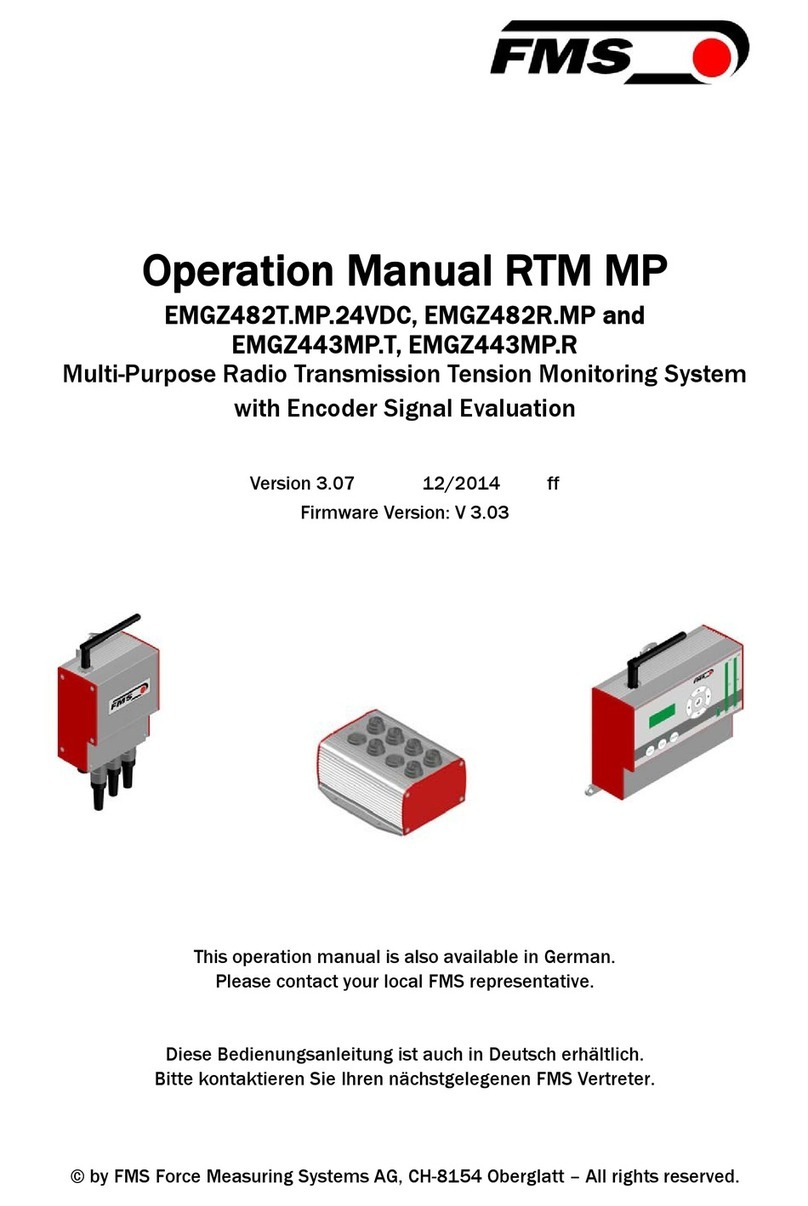Mantracourt X24 User manual

X24 ATEX/IECEx Telemetry User Manual
mantracourt.com
X24
Wireless ATEX/IECEx Telemetry
This user manual should be used in conjunction with the T24 Telemetry User Manual
MICRON METERS
www.micronmeters.com

Mantracourt Electronics Limited T24 Telemetry User Manual
1
Introduction / Overview.............................................................................................................................................4
Navigating This Manual .............................................................................................................................................4
Product Quick Locator................................................................................................................................................4
X24 and T24 Telemetry Basic Principles ..................................................................................................................5
Transmitters & Receivers.........................................................................................................................................................................5
Transmitters..............................................................................................................................................................................................5
Receivers....................................................................................................................................................................................................5
Radio Channel and Group Key ..............................................................................................................................................................5
Radio Channel .........................................................................................................................................................................................5
Group Key..................................................................................................................................................................................................5
Configuring Multiple Modules to Use the Same Radio Settings.............................................................................................6
ID and Data Tags.........................................................................................................................................................................................6
Transmitter Module Modes of Operation.........................................................................................................................................6
Operational (Low Power Mode) .......................................................................................................................................................6
Operational (Non Low Power Mode) .............................................................................................................................................6
Configuration...........................................................................................................................................................................................6
Sleep............................................................................................................................................................................................................6
Transmitter Module Sleep Delay Settings.........................................................................................................................................7
Pairing .............................................................................................................................................................................................................7
Pairing From T24 Toolkit .....................................................................................................................................................................7
Pairing From a Receiver Module ......................................................................................................................................................7
Soft Pairing....................................................................................................................................................................................................8
Configuring an Attached Base Station ...............................................................................................................................................8
Asynchronous Operation and Logging..............................................................................................................................................8
Bandwidth......................................................................................................................................................................................................9
Repeaters and Repeater Subgroups ...................................................................................................................................................9
T24 Toolkit ................................................................................................................................................................ 10
Common Toolkit Pages ........................................................................................................................................... 11
Setup Base Station Communications............................................................................................................................................... 11
Analyser ....................................................................................................................................................................................................... 12
Channel Monitor ...................................................................................................................................................................................... 13
Home ............................................................................................................................................................................................................ 15
Connecting to a remote module................................................................................................................................................... 15
Connecting to the attached base station module ................................................................................................................. 16
Manual Connection ............................................................................................................................................................................ 16
Information................................................................................................................................................................................................. 17
Battery and Radio Levels.......................................................................................................................................................................18
Battery and Radio Levels Advanced ................................................................................................................................................. 19
Radio Settings ........................................................................................................................................................................................... 20
Radio Settings Advanced...................................................................................................................................................................... 21
Save and Restore ..................................................................................................................................................................................... 22
Transmitter Modules ............................................................................................................................................... 23
X24-ACMi-SA, X24-SAe, X24-SAi....................................................................................................................................................... 23
Overview ................................................................................................................................................................................................. 23
Order Codes .......................................................................................................................................................................................... 23
X24-SAe.............................................................................................................................................................................................. 23
T24-ACMi-SA.................................................................................................................................................................................... 23
Connections........................................................................................................................................................................................... 24
X24-SAe, X24-SAi............................................................................................................................................................................ 24
Power.............................................................................................................................................................................................. 24
Sensor............................................................................................................................................................................................. 24
X24-ACMi-SA ................................................................................................................................................................................... 25
Power.............................................................................................................................................................................................. 25
Sensor............................................................................................................................................................................................. 25
Configuration........................................................................................................................................................................................ 26
Data Rates and Quality.................................................................................................................................................................26

Mantracourt Electronics Limited T24 Telemetry User Manual
2
Calibration ......................................................................................................................................................................................... 28
Calibration by Certificate............................................................................................................................................................. 30
Calibration Advanced.................................................................................................................................................................... 31
Advanced Settings.......................................................................................................................................................................... 32
Enclosure & Mounting...................................................................................................................................................................... 33
X24-SAe, X24-SAi............................................................................................................................................................................ 33
X24-ACMi-SA ................................................................................................................................................................................... 33
Antennas................................................................................................................................................................................................. 33
X24-SAe.............................................................................................................................................................................................. 33
X24-ACMi-SA ................................................................................................................................................................................... 33
Specification.......................................................................................................................................................................................... 34
Radio Range...................................................................................................................................................................................... 34
Receiver Modules ..................................................................................................................................................... 35
X24-HD......................................................................................................................................................................................................... 35
Overview ................................................................................................................................................................................................. 35
Order Codes .......................................................................................................................................................................................... 35
X24-HD........................................................................................................................................................................................... 35
Connections........................................................................................................................................................................................... 35
Power.............................................................................................................................................................................................. 35
Quick Start.............................................................................................................................................................................................. 36
Connecting Power.......................................................................................................................................................................... 36
X24-HD........................................................................................................................................................................................... 36
Transmitter Module .................................................................................................................................................................. 36
Viewing Transmitter Data............................................................................................................................................................ 36
Operation........................................................................................................................................................................................... 37
Keys ................................................................................................................................................................................................. 37
Indicators....................................................................................................................................................................................... 37
Errors............................................................................................................................................................................................... 38
Configuration........................................................................................................................................................................................ 39
Modes of Operation ...................................................................................................................................................................... 39
No List Entered (Default)......................................................................................................................................................... 39
List Entered................................................................................................................................................................................... 39
List Entered Plus Summing Groups ....................................................................................................................................39
Global Settings ................................................................................................................................................................................40
Configure Inputs ............................................................................................................................................................................. 42
No Defined Transmitters......................................................................................................................................................... 42
Defined Transmitters ................................................................................................................................................................ 44
General Tab.............................................................................................................................................................................. 44
Zero Tab.................................................................................................................................................................................... 46
Scaling Tab............................................................................................................................................................................... 48
Group Membership Tab...................................................................................................................................................... 49
Summing Groups ....................................................................................................................................................................... 50
General Tab.............................................................................................................................................................................. 50
Zero Tab.................................................................................................................................................................................... 52
Scaling Tab............................................................................................................................................................................... 54
Members Tab..........................................................................................................................................................................56
Example Configuration Scenarios ............................................................................................................................................ 57
Examples Using No Defined Transmitter List (Roaming Mode).............................................................................. 57
Long Bridge ............................................................................................................................................................................. 57
Brewery...................................................................................................................................................................................... 57
Example of Defined Transmitter List .................................................................................................................................. 57
Single Transmitter ................................................................................................................................................................. 57
Multiple Transmitters........................................................................................................................................................... 57
Example of Summing Groups ............................................................................................................................................... 57
Alternative Units .................................................................................................................................................................... 57
Grouping Sums....................................................................................................................................................................... 58

Mantracourt Electronics Limited T24 Telemetry User Manual
3
Enclosure & Mounting...................................................................................................................................................................... 60
Antennas................................................................................................................................................................................................. 60
Specification.......................................................................................................................................................................................... 61
Radio Range...................................................................................................................................................................................... 61
Appendices................................................................................................................................................................ 62
Appendix A - Enclosures....................................................................................................................................................................... 62
OEM Transmitter Modules............................................................................................................................................................... 62
Dimensions........................................................................................................................................................................................ 62
Opening the Case........................................................................................................................................................................... 62
Mounting Information.................................................................................................................................................................. 62
Antenna Position............................................................................................................................................................................. 63
Environmental Protection............................................................................................................................................................ 63
ACMi Type.............................................................................................................................................................................................. 64
Dimensions........................................................................................................................................................................................ 64
Opening the Case........................................................................................................................................................................... 64
Mounting Information.................................................................................................................................................................. 64
Antenna Position............................................................................................................................................................................. 65
Environmental Protection............................................................................................................................................................ 65
Handheld Type..................................................................................................................................................................................... 66
Dimensions........................................................................................................................................................................................ 66
Opening the Case........................................................................................................................................................................... 66
Mounting Information.................................................................................................................................................................. 67
Antenna Position............................................................................................................................................................................. 67
Environmental Protection............................................................................................................................................................ 67
Appendix B - Antennas..........................................................................................................................................................................68
Overview ................................................................................................................................................................................................. 68
T24-ANTA............................................................................................................................................................................................... 69
Mounting ........................................................................................................................................................................................... 69
Specification ..................................................................................................................................................................................... 69
Antenna Range..................................................................................................................................................................................... 70
Appendix C - Radio Specification...................................................................................................................................................... 71
Appendix D –CE, FCC and IC Approval Statements.................................................................................................................. 72
CE............................................................................................................................................................................................................... 72
IC................................................................................................................................................................................................................ 73
FCC............................................................................................................................................................................................................ 74
Appendix E - OEM / Reseller Marking and Documentation Requirements .....................................................................75
CE............................................................................................................................................................................................................... 75
IC................................................................................................................................................................................................................ 76
FCC............................................................................................................................................................................................................ 77
Appendix F - Worldwide Regional Approvals .............................................................................................................................. 78
Important Note .................................................................................................................................................................................... 78
Appendix G –ATEX & IEC..................................................................................................................................................................... 79
Declarations and Attestations of Conformity........................................................................................................................... 79
ATEX Examination Certificates ....................................................................................................................................................... 80
X24-SAe, X24-SAi............................................................................................................................................................................ 80
X24-ACMi-SA ................................................................................................................................................................................... 83
X24-HD ............................................................................................................................................................................................... 85
IEX Ex Certificates of Conformity .................................................................................................................................................. 87
X24-SAe, X24-Sai ............................................................................................................................................................................ 88
X24-ACMi-SA ................................................................................................................................................................................... 89
X24-HD ............................................................................................................................................................................................... 90
Appendix H - Warranty.......................................................................................................................................................................... 91

Mantracourt Electronics Limited T24 Telemetry User Manual
4
Introduction / Overview
The X24 Telemetry range of products are ATEX and IECEx approved members of the larger T24 Telemetry product
range. Systems can be put together using X24 in the hazardous areas and T24 in safe areas as required.
The radios operate on the licence free 2.4 GHz band and are approved for FCC, IC and European use.
The flexible transmission rates and low power usage allows for long battery/cell life for remote modules.
Free Toolkit software provides simplified configuration of modules and other free software provides logging and
visualisation functionality for Windows PCs.
When using X24 products you will also need to refer to the T24 Telemetry User Manual and also be aware that
X24 products are configured using the T24 Toolkit software in conjunction with a T24 base station.
Navigating This Manual
When viewing this PDF manual the following tips will help you navigate.
Viewing bookmarks ( or ) to the left of the page, in the PDF viewer, will allow easy navigation to the relevant
chapters of this manual. Alt-left arrow is a useful shortcut back to the last page viewed after a hyperlink is clicked.
Hyperlinks are coloured yellow and are underlined.
Product Quick Locator
This section allows you to locate your product quickly to navigate to the correct section of the manual.
Strain Input
X24-ACMi-SA
X24-SAe
Receivers
X24-HD
T24 modules cannot be used in hazardous areas!

Mantracourt Electronics Limited T24 Telemetry User Manual
5
X24 and T24 Telemetry Basic Principles
There are some basic radio settings and concepts that should be understood to effectively configure, deploy,
optimise and troubleshoot X24 and T24 telemetry systems.
Transmitters & Receivers
Although all of the X24 modules are in fact transceivers and transmit as well as receive, they tend to mainly
operate as either a transmitter or receiver so we will choose to describe them as Transmitters and Receivers.
The X24 system was designed so that Transmitters are configured to send out messages at a user defined rate.
Receivers can then use this data to analyse, display or perform other actions depending on their function.
A PC and base station are only required to configure the modules although they may be part of a data collection
system. Once configured the X24 modules operate autonomously and only minimal control over the Transmitter
modules is usually required, by Receiver modules, such as sleeping or waking.
Transmitters
These are the sensor modules that measure inputs, such as strain, and send messages containing the sensor value
and status information at regular intervals for use by Receiver modules or for delivering to a PC via a base station.
Because these modules need to be very power efficient to operate on batteries they operate in three distinct
modes. See Transmitter Module Modes of Operation later.
Receivers
These modules use messages provided by Transmitters and have functionality such as handheld displays, large
displays, analogue outputs and relay modules. These modules may also offer control over Transmitter modules
such as sleeping or waking. X24 currently has only one Receiver in the range (The X24-HD handheld display) but
the X24 Transmitters can be used with any of the T24 Receivers.
Radio Channel and Group Key
To be able to communicate, two radio modules must share some basic settings. There are ways to learn these and
to recover unknown settings and these are discussed later in the pairing section.
Radio Channel
This is the frequency that the radio operates on. Radio bandwidth is divided into 15 channels. Modules must be
on the same channel to be able to transfer messages.
Group Key
Group keys are a way of isolating groups of modules even if they are operating on the same radio channel. This
can improve efficiency and also offer security because no radio module can affect another or see their messages
unless they share the same group key.
A group key is defined by the user and is up to 15 alphanumeric characters.
Group keys were introduced in v3.0 radio firmware in March 2015. New radio modules will work with older radio
modules but group keys cannot be used.

Mantracourt Electronics Limited T24 Telemetry User Manual
6
Configuring Multiple Modules to Use the Same Radio Settings
Please note that when you pair to a remote module the base station adopts the radio channel and group key of
the remote module.
To set the group key for a set of remote modules you can either:
Pair to each one in turn and set their radio channel and group key.
or
Configure the base station by holding the shift key and clicking the Pair button on the Home page. Then
configure the base station to the required radio settings then use the tool on the radio settings advanced
page to pair to each module in the set to configure their radio settings to match the base station.
ID and Data Tags
To configure a module its ID is used in communications. This is a unique 6 character identifier, such as FF1234,
which is allocated at the factory. This ID is hexadecimal so can consist of numbers 0-9 and letters A-F.
If a module is a Transmitter it sends messages without broadcasting its ID. It identifies messages by using a Data
Tag. This tag is a 4 character hexadecimal number and can be configured by the user. When modules leave the
factory this data tag is set to the last 4 characters of its ID.
When Receiver modules or software want to use messages sent by Transmitter modules they identify the
message they want by this Data Tag.
The reason Transmitter module messages are identified by a Data Tag rather than the unique ID is that this allows
replacement of a Transmitter module without having to reconfigure the many Receiver modules that may be
using its messages. It is only necessary to configure the replacement Transmitter module with the same data tag,
radio channel and group key and the rest of the system will not notice the difference.
Transmitter Module Modes of Operation
Operational (Low Power Mode)
Normal mode involves taking a reading and sending a message then entering into a very low power state before
taking the next reading to maximise battery life.
Because it is not possible to communicate with the Transmitter module during this low power state a
‘Configuration’ mode is required.
Operational (Non Low Power Mode)
If battery life is not an issue, modules are externally powered or transmission rates are so high that low power
mode is not available then the modules do not enter a low power state between transmissions.
Configuration
Configuration mode forces the modules to pause in sending their messages and to disable their low power state
to enable configuration to take place. This is easily achieved by ‘Pairing’ when using the T24 Toolkit software.
Once configuration is complete the modules will resume their ‘normal’ mode operation.
Sleep
The last mode is sleep. Modules can be sent to sleep by other modules or they can go to sleep themselves when
their messages are no longer being used. See Sleep Delay Settings later.
When sleeping, the modules can be awakened on demand by other modules or software via the base station.

Mantracourt Electronics Limited T24 Telemetry User Manual
7
Transmitter Module Sleep Delay Settings
Transmitter modules have a Sleep Delay setting (set in seconds) which allows the modules to go into Sleep mode
when their data messages are no longer required. This allows much longer battery life to be achieved.
Setting Sleep Delay to zero disables this function in the Transmitter modules and they will only go into Sleep
mode when told to do so.
Most Receiver modules and T24 software send Stay Awake messages when they see messages arrive from
Transmitter modules. In the Transmitter modules, if the Sleep Delay time period has elapsed without a Stay
Awake message arriving then the module will enter Sleep mode.
Usually the Stay Awake messages are sent every 5 seconds so Sleep Delays should be set to at least 10 seconds
but can be set to anything up to an hour for situations where the Receiver is likely to be out of range for periods
of time but where the Transmitter module is required to stay awake and in normal operational mode during that
time. It is usual that Sleep Delays are set somewhere between 30 and 300 seconds when required.
Pairing
Because you need to know the radio settings configured in a module to be able to configure it, and there are no
visible clues to what those settings may be, there is a feature used by X24 and T24 modules that enable the radio
settings (i.e. the radio channel and the group key) to be determined and matched between two modules.
Pairing is only required to determine and match radio settings and optionally to put X24 Transmitter modules in
configuration mode. Because in some installations the X24 modules can be buried deep inside other equipment
there had to be a way of indicating that a module has been selected to pair with without having physical access
to that module. Pairing was therefore designed to be activated by removing and re-applying the module’s power.
In some cases this is not practical so another possible solution is Soft Pairing see later.
Pairing From T24 Toolkit
When using the T24 Toolkit and a base station, pairing is used to connect to a module without having to know
anything about it beforehand. To pair, remove power from the required module, click a ‘Pair’ button in the
software and re-apply power to the module. The base station and module negotiate settings and the base
station is automatically configured to match the radio settings from the module and places the module into
configuration mode. Now the module can be configured and when complete it will return to normal operational
mode.
Pairing From a Receiver Module
Some Receiver modules allow pairing to a Transmitter module without requiring the T24 Toolkit. For example
some handheld readers offer this feature by turning them on while holding a certain key after which the power is
applied to the Transmitter module. The radio settings are then negotiated and the Transmitter module is
automatically configured to match the handheld radio settings. The handheld learns the ID and data tags
required to be able to use messages from the Transmitter module. In this case no configuration mode is required
so the Transmitter module simply continues to operate in normal mode but with altered radio settings.

Mantracourt Electronics Limited T24 Telemetry User Manual
8
Soft Pairing
Pairing by power cycling is absolute and will work under all circumstances. However, sometimes access to the
power supply of a module that you want to pair to can be restricted, a module 20 meters up a tower for example,
so the T24 Toolkit offers a way to soft pair.
To achieve this you need to know the radio channel and group key of the remote module and configure
the base station to match this. You must also know the unique ID of the module and armed with this you
can soft pair to the module. This works quite well with Receiver modules as they are not operating in low power
modes but the software does need to try and change Transmitter modules from their normal operation mode
into configuration mode.
This may not always work reliably in high traffic or high noise environments because there are a lot of messages
that need to be sent between the base station and the remote module which can be upset by the presence of too
many other messages on the same radio channel. If a connection cannot be made then power cycle pairing may
be the only option.
Configuring an Attached Base Station
Because a base station is attached to your computer when you are using the T24 Toolkit you do not pair to it the
same way as with other X24 and T24 modules. To configure the base station using the Toolkit hold the shift key
and click the Pair button on the Home page.
Asynchronous Operation and Logging
Transmitters send their messages at a fixed user defined interval regardless of whether anything is listening. This
message interval is timed from when the Transmitter has been woken or powered on so there is no
synchronisation of when the actual measurement is taken between different transmitters.
If you are logging information from multiple Transmitters using multiple channel logging software you should be
aware of how the software will store and record values.
The software stores the message values as they arrive from each Transmitter and when a log is to be recorded it is
the last value received by each Transmitter that is used.
This means that the values that are recorded could have been measured at any point during the Transmitter
message interval.
For example, if there are 10 Transmitters operating at 333ms message interval then when the values are recorded
to the log file you can only be sure that those values had been recorded within 333ms of each other.
So if there is a requirement that recorded sets of readings are within a certain time of each other, then that time is
the maximum message interval that should be set for the Transmitters regardless of the actual log interval of the
software (Which should always be greater than the Transmitter message interval).

Mantracourt Electronics Limited T24 Telemetry User Manual
9
Bandwidth
Each radio channel (1-15) has a finite ability to carry information. When modules do not need to communicate
with each other they can be configured on separate radio channels and do not affect each other.
However, when multiple modules are on the same radio channel, even if they use different group keys, they are
all contributing to filling the available bandwidth.
Each message transmitted takes up around 3 milliseconds so if everything worked perfectly and all modules
transmitted at just the right time and with no gaps between then there could only ever be 300 messages per
second being transmitted on any one radio channel.
In reality there are factors that reduce this capacity.
Each module uses a technique to detect whether anyone else is transmitting before it transmits itself and this
takes a finite time. There can also be interference from other sources that can delay module transmissions.
Because of the transmission rate flexibility of the X24 modules there could be a few modules transmitting
messages at fast rates or many modules transmitting messages at slow rates or any combination of these.
Practically there is a limit of around 200 messages per second available per radio channel.
It should be noted that as the number of Transmitter modules increases there is more chance of message
collisions and so more messages are lost (remember that the Transmitter modules are sending their messages
out at regular intervals) thus reducing the average number of messages per second arriving per module.
So, for example, 2 modules may transmit at 100 times per second or 100 modules at a rate of 1 per second.
Repeaters and Repeater Subgroups
Repeaters are able to retransmit messages so that the repeated signal is stronger than the original and so can
increase the range of systems or can bypass obstacles.
The repeater must be configured to operate on the same radio channel and use the same group keys as those
modules it is repeating.
Because the radio traffic is effectively doubled by a repeater there is a mechanism to reduce unnecessary
repetition of messages.
Sometimes a repeater will still see messages from modules that do not need to be repeated (Thus filling up
available bandwidth) so both repeaters and all other X24 and T24 modules have a setting called the repeater
subgroup.
By default all subgroup settings are set to zero. A repeater will repeat a message from all modules whose
subgroup is either zero or matches its own subgroup. If a repeater subgroup is zero it will repeat messages from
all modules.
This is a simple way to break down modules into smaller groups and control what messages get repeated.
Changing the repeater subgroup is not normally necessary unless the bandwidth is very full due to either many
Transmitter modules being present or very fast transmissions from modules.

Mantracourt Electronics Limited T24 Telemetry User Manual
10
T24 Toolkit
To configure the modules you must use the T24 Toolkit software application. This can be downloaded from our
web site or may be shipped with your products.
The software is suitable for all versions of Windows.
Run the installer and follow the prompts to install the software.
In the Toolkit all items that can be changed or interacted with by the user are coloured green.
To change a value just click on the relevant green item. You will then be presented with a new dialog window
allowing you to change the value.
This may use a slider, text box or list to allow your new value to be entered.
A base station will also be required to configure the X24 and T24 modules. If you have a USB version of the base
station (T24-BSu or T24-BSue) then you just need to plug this into a USB socket on your PC. If you are using an
alternative base station then please refer to the appropriate section of the T24 Telemetry User Manual.

Mantracourt Electronics Limited T24 Telemetry User Manual
11
Common Toolkit Pages
These pages in the T24 Toolkit are applicable to all connected modules.
Setup Base Station Communications
Select the appropriate interface type for the connected base station. If the base station is connected via a serial
port then you will need to know the COM port it is connected to and the baud rate.
The Base Station Address is usually 1. This will only ever be different if it has been changed on base stations to
support multi base station configurations.
Click the Home button to attempt communications with the base station.
If no communications can be established the toolkit will remain on this page. You will need to check that the base
station is powered and that it is connected to any converters correctly.

Mantracourt Electronics Limited T24 Telemetry User Manual
12
Analyser
The analyser page is provided as a tool and will not normally be needed unless you plan to change channels and
want to find the best channel to select, or to diagnose poor communications issues.
This page shows the radio signal levels detected across all the channels available to the X24 and T24 series of
modules. Using this tool may help in detecting noisy areas and allow you to decide on which channels you may
want to use.
The above charts show the traffic from a Wi-Fi network and it can be seen to be operating over channels 12 to 16
and it would be best (though not essential) to avoid using these channels.
Although 16 channels are shown the X24 and T24 modules operate over radio channels 1 to 15.

Mantracourt Electronics Limited T24 Telemetry User Manual
13
Channel Monitor
This page shows a summary of data sent by transmitter modules.
You can see the Data Tag of transmitted messages along with the total number of messages received, the
transmission rate, link quality, data value and any error messages.
Some base stations can also list modules that are sleeping. These will show an ID instead of a Data Tag.
To see any data the base station must be on the same radio channel as the transmitters and
must have a matching Group Key
The radio channel of the base station can be changed by clicking the channel tabs along the top of the page.
If you want to change the Group Key of the attached base station you need to configure its radio settings. See
Configure Base Station
Items you can change or interact with:
Radio Channel Tabs
Click a tab to change the radio channel the base station is operating on
Clear List
Clear all detected messages from the list
Wake All
Wake all modules on the current radio channel

Mantracourt Electronics Limited T24 Telemetry User Manual
14
Start Logging
Asks for a filename then logs the received data to a CSV file in the following
format:
Data Tag, Elasped ms, Value
View Last Log
Will launch the application associated with CSV files and open the last logged
file.
Move Group Channel
If the base station has a group key set then this button will be visible. Once at
least one module is present in the list this button will become enabled. Clicking
it will ask the user for a new radio channel then all detected transmitters, along
with all other modules on the same channel and group key such as handhelds,
will all be moved to the selected channel. Once this has been achieved the base
station itself will move and the list will start to fill again with messages on the
new radio channel.
You will only see a list of detected transmitters on this page so
you will need to ensure that any other receiver modules in the
group are available to be woken.
When this button is clicked all modules on the same radio
channel and group key will be woken before they are changed
to the target radio channel.

Mantracourt Electronics Limited T24 Telemetry User Manual
15
Home
You now have successful communications with the base station so you can now pair with your remote X24
module or you can select the Spectrum Analyser mode or Data Provider Monitor mode.
Connecting to a remote module
To connect to a remote module you will pair. This is achieved by power cycling the module. Pairing removes the
need to know the radio settings of the module you are connecting to and also ensures that it is in a suitable state
for configuration.
Pairing Procedure
Remove power from the X24 module.
Click the Pair button on the Toolkit.
You now have 10 seconds to re-apply power to the X24 module.
If you connect successfully the Toolkit will change to the Information page. If the pairing fails try again.
Pairing with the toolkit will not change the radio configuration settings of the connected
module. The base station radio settings will be changed to match those of the remote
module.
When the toolkit connects to a remote module to enable configuration it will usually inhibit
the normal operational transmission of messages

Mantracourt Electronics Limited T24 Telemetry User Manual
16
Connecting to the attached base station module
To connect to and configure the connected base station, hold the shift key and click the Pair button.
Manual Connection
If you cannot get to the power supply of the remote module you can attempt to connect manually using Soft
Pairing. Click the ‘Click Here’ link at the bottom of the page and follow the prompts.

Mantracourt Electronics Limited T24 Telemetry User Manual
17
Information
Once successfully paired to a module this page is displayed showing you information about the connected
module.
Items you can change:
Name
You can enter a short description which may help you recognise this module in
the future.
Features
Each module may support certain features which are indicated on this page. If the feature is greyed out then it is
not supported. If it is coloured then it is supported.
Some transmitter modules may have had their calibration protected. This
indicates that you cannot calibrate this module.
Group Keys were introduced in 2015 so modules built before this date will not
support this feature. This indicates that the connected module can support them
This indicates that the connected module can support Group Keys and that one
has been configured for this module
Applicable to a base station only. This indicates that on the Channel Monitor page
modules that are sleeping will also be listed
Extended range radios were introduced to the T24 range in 2015. This indicates
that the connected module has an extended range radio fitted.

Mantracourt Electronics Limited T24 Telemetry User Manual
18
Battery and Radio Levels
Available for Transmitters only. Here you can see the voltage of the battery and the radio signal levels at the base
station and the remote transmitter module. This simple view gives an LQI value which stands for Link Quality
Indicator. This value will range from 0 to 100 and within this band you should still achieve communications. As the
level drops towards zero communications may become intermittent but still achievable.
On modules that are battery powered the battery voltage section will be visible. You can set the level at which the
transmitter module reports a low battery. (At 2.1 V the module will stop working)
If the battery voltage is below the Low Battery Level the bar will be coloured orange.
Items you can change:
Low Battery Level
Click this item to set the battery low level. For the Energizer L91 cells this should
be around 2.7 V.
Clicking the Advanced button will give more detailed information on the RSSI and CV levels of the received radio
packets.

Mantracourt Electronics Limited T24 Telemetry User Manual
19
Battery and Radio Levels Advanced
LQI value which stands for Link Quality Indicator. This value will range from 0 to 100 and within this band you
should still achieve communications. As the level drops towards zero communications may become intermittent
but still achievable. This is calculated from the RSSI and CV values.
RSSI is effectively the received dB level which will range from about -30 which is a good signal to -98 which is a
weak signal.
CV is the correlation value and indicates how well the signal can be decoded. This ranges from 55 which is a poor
quality signal and 110 which is an excellent signal.
This manual suits for next models
1
Table of contents
Other Mantracourt Measuring Instrument manuals
Popular Measuring Instrument manuals by other brands
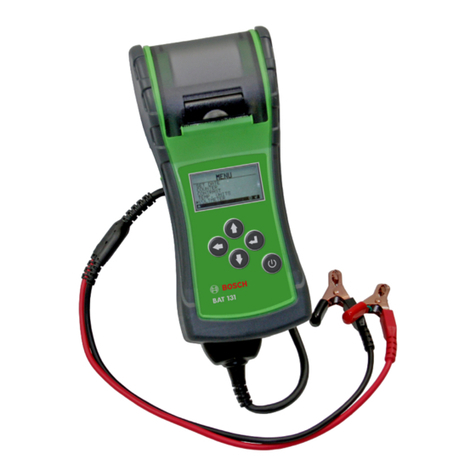
Bosch
Bosch BAT 131 Original instructions
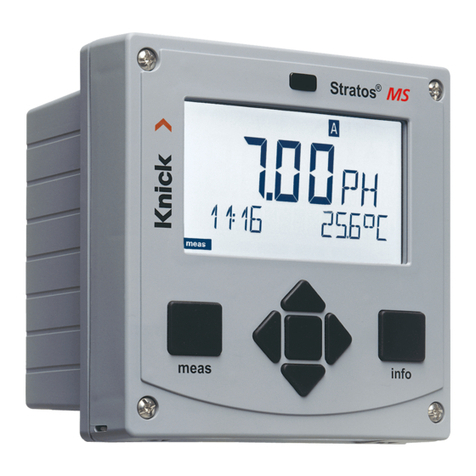
Knick
Knick Stratos Pro A4..MSPH series instruction manual
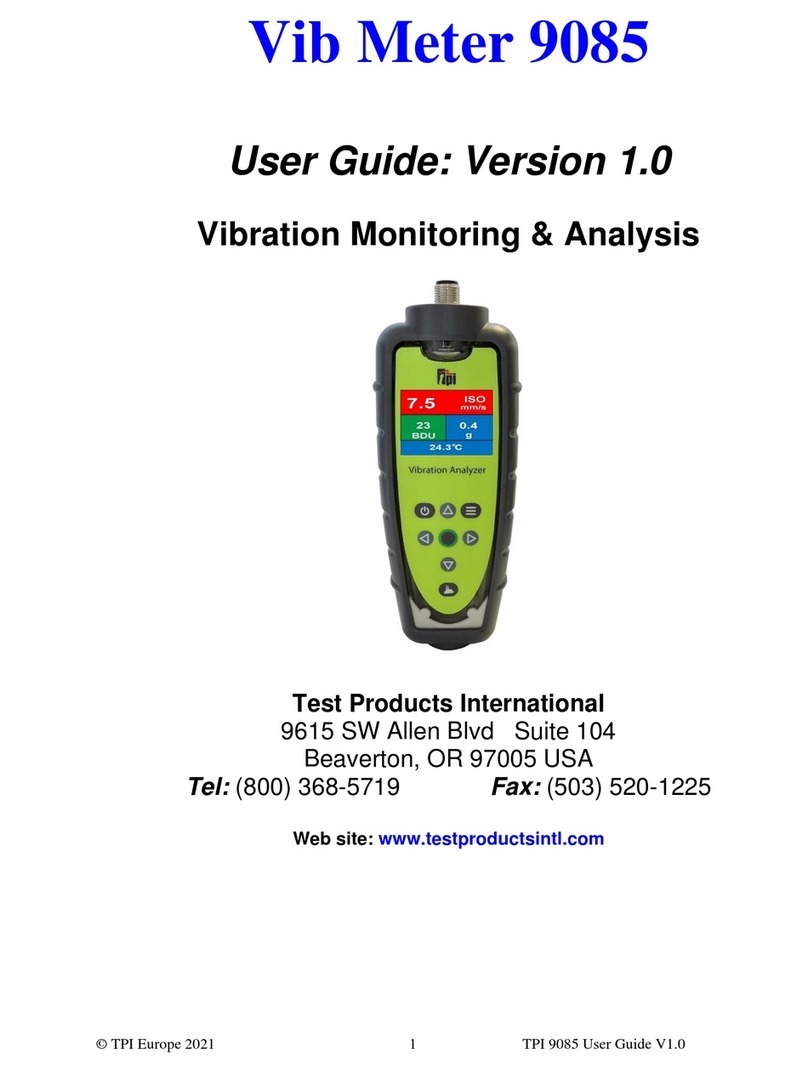
Test Products International
Test Products International Vib Meter 9085 user guide
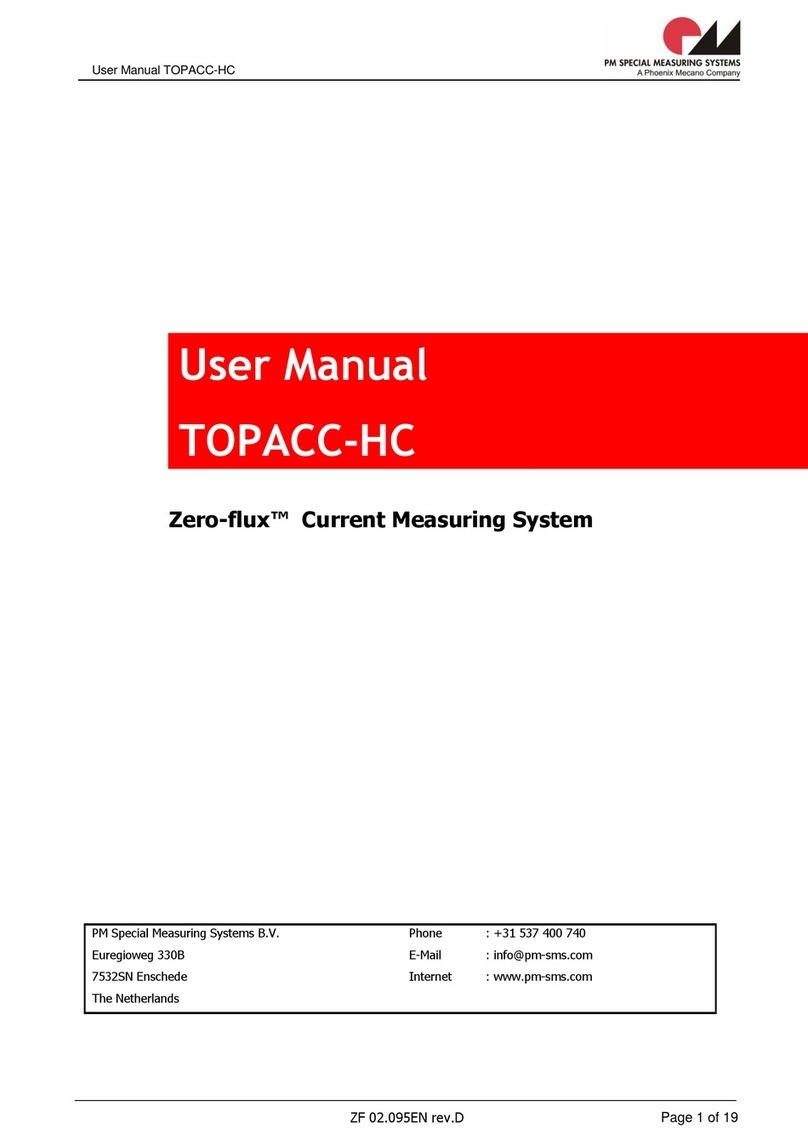
Phoenix Mecano
Phoenix Mecano Zero-flux TOPACC-HC user manual
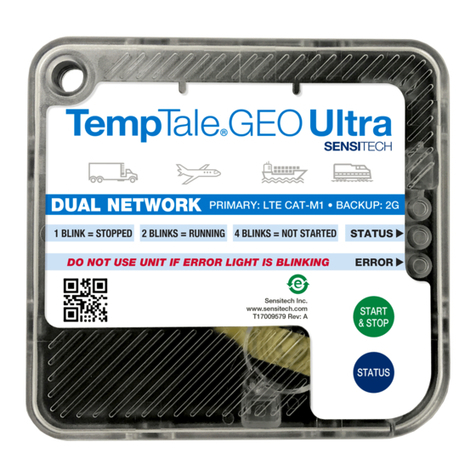
Sensitech
Sensitech TempTale GEO Placement instructions
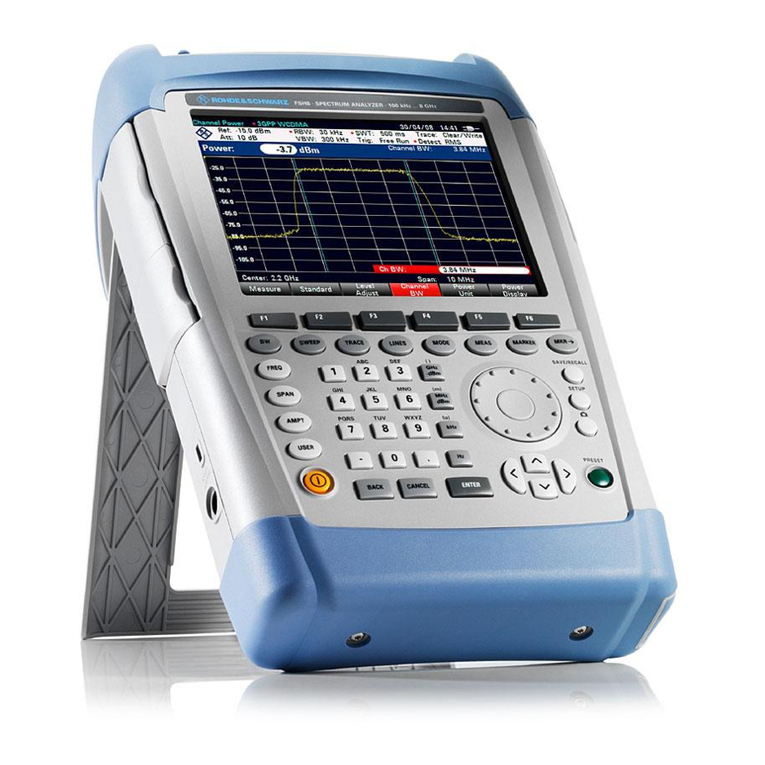
Rohde & Schwarz
Rohde & Schwarz FSH4 quick start guide
